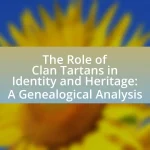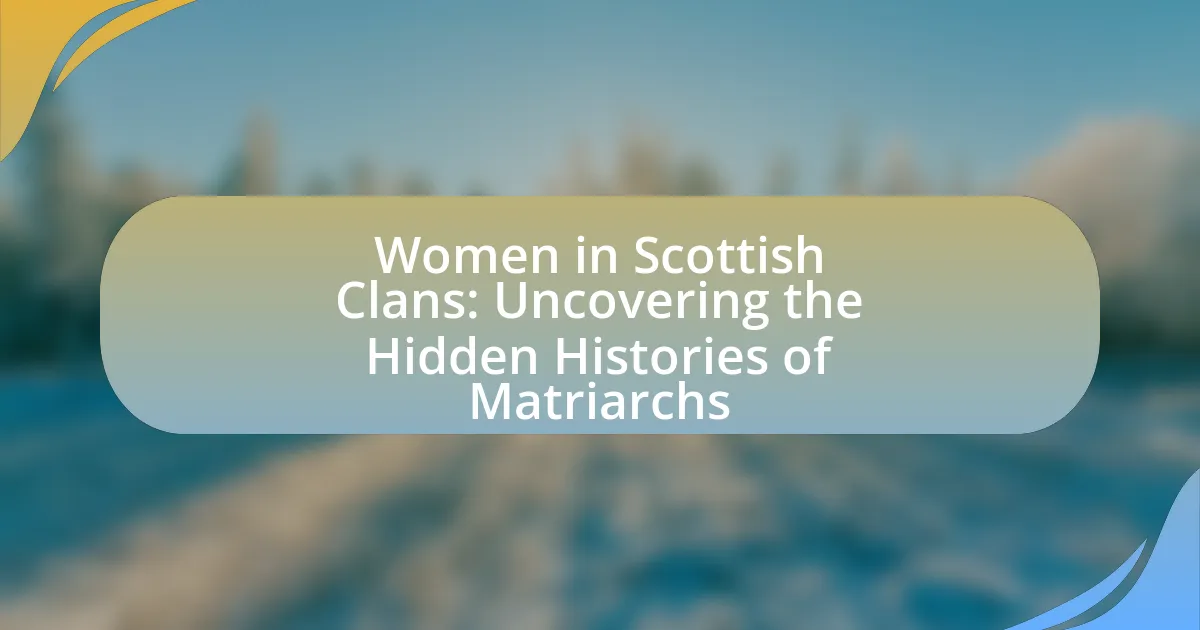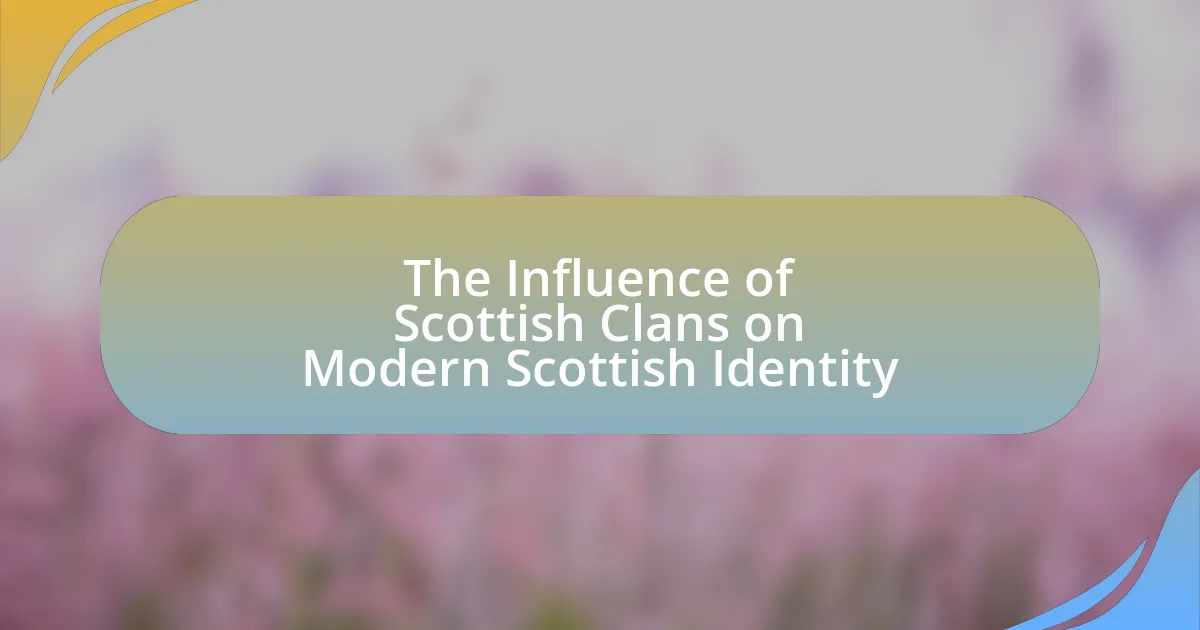DNA testing is a scientific method that analyzes genetic material to uncover ancestry and familial relationships, particularly relevant for tracing Scottish heritage. The article explores the different types of DNA tests—autosomal, Y-DNA, and mitochondrial DNA—and their specific applications in understanding Scottish ancestry, including connections to historical clans and genetic diversity. It also addresses the importance of DNA testing in reconstructing family histories, the limitations of such tests, and best practices for combining genetic analysis with traditional genealogy. Additionally, the article provides guidance on how to get started with DNA testing, interpret results, and utilize various resources for exploring Scottish ancestry.
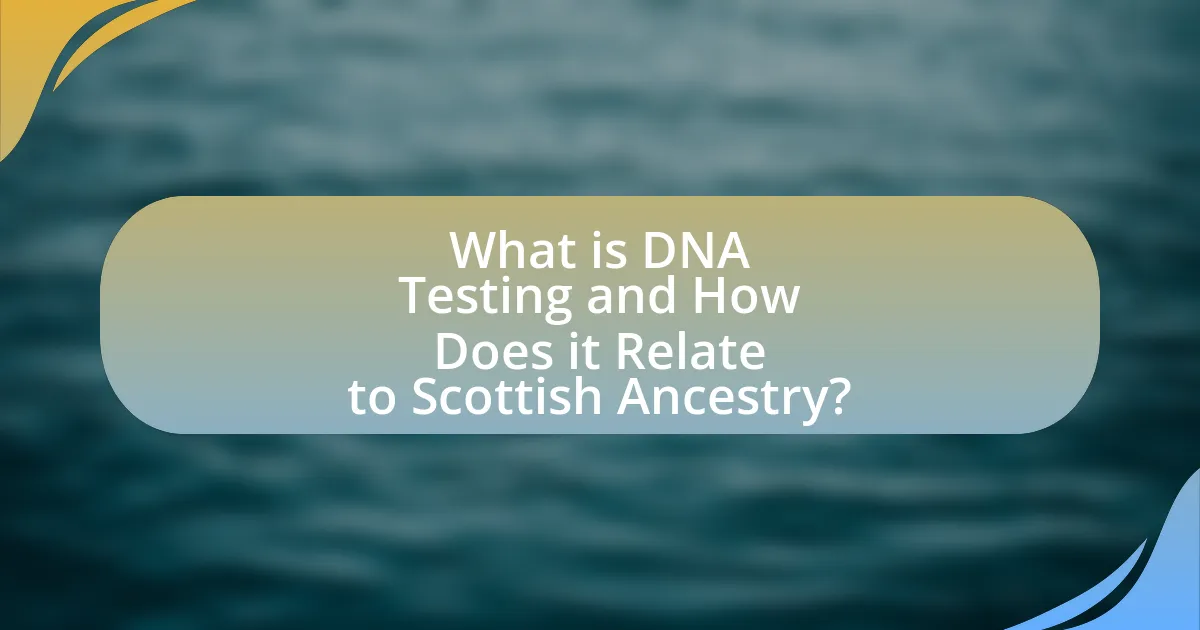
What is DNA Testing and How Does it Relate to Scottish Ancestry?
DNA testing is a scientific method used to analyze an individual’s genetic material to determine ancestry and familial relationships. In relation to Scottish ancestry, DNA testing can reveal genetic markers that are specific to Scottish populations, helping individuals trace their lineage and identify connections to historical clans or regions in Scotland. Studies have shown that certain haplogroups, such as R1b, are prevalent among Scottish males, indicating a shared ancestry that can be traced back thousands of years. This genetic information can provide insights into an individual’s heritage, confirming or challenging family histories and connecting them to Scotland’s rich cultural and historical tapestry.
What types of DNA tests are available for ancestry research?
There are three main types of DNA tests available for ancestry research: autosomal DNA tests, Y-DNA tests, and mitochondrial DNA tests. Autosomal DNA tests analyze the 22 pairs of non-sex chromosomes inherited from both parents, providing a broad overview of ancestry and ethnicity. Y-DNA tests focus on the Y chromosome, which is passed from father to son, allowing for paternal lineage tracing. Mitochondrial DNA tests examine the mitochondrial DNA passed from mother to child, enabling maternal lineage tracking. These tests collectively offer comprehensive insights into an individual’s ancestral roots and genetic heritage.
How do autosomal, Y-DNA, and mtDNA tests differ?
Autosomal, Y-DNA, and mtDNA tests differ primarily in the type of genetic information they analyze and the ancestry insights they provide. Autosomal DNA tests examine the 22 pairs of non-sex chromosomes inherited from both parents, offering a broad view of ancestry from all ancestral lines, typically covering the last five to six generations. Y-DNA tests focus exclusively on the Y chromosome, which is passed down from father to son, making it useful for tracing direct paternal lineage and surname origins. In contrast, mtDNA tests analyze mitochondrial DNA, inherited from the mother, allowing for the exploration of direct maternal ancestry. Each test serves distinct purposes: autosomal tests provide a comprehensive ancestry overview, Y-DNA tests trace paternal lines, and mtDNA tests reveal maternal lineage.
What specific information can each type of test provide about Scottish ancestry?
Y-DNA tests provide information about direct paternal lineage, tracing male ancestry through the Y chromosome, which can reveal connections to specific Scottish clans or regions. Mitochondrial DNA (mtDNA) tests offer insights into direct maternal lineage, tracing ancestry through the maternal line, which can help identify ancient maternal roots in Scotland. Autosomal DNA tests analyze genetic contributions from both parents, providing a broader picture of ancestry, including ethnic percentages and potential relatives within Scotland. Each test type contributes uniquely to understanding Scottish ancestry by revealing different aspects of lineage and heritage.
Why is DNA testing important for understanding Scottish heritage?
DNA testing is important for understanding Scottish heritage because it provides insights into ancestral origins and genetic connections to historical populations. By analyzing specific markers in the DNA, individuals can trace lineage back to ancient Scottish clans and migrations, revealing connections to the Picts, Celts, and Norse settlers. Studies have shown that genetic data can correlate with historical records, enhancing the understanding of Scotland’s diverse heritage and the movement of peoples over centuries. This genetic evidence supports the reconstruction of family trees and helps individuals connect with their cultural identity, making DNA testing a valuable tool for exploring Scottish ancestry.
How can DNA testing reveal connections to historical Scottish clans?
DNA testing can reveal connections to historical Scottish clans by analyzing specific genetic markers that are associated with particular lineages. These markers, such as Y-DNA for paternal lineage and mtDNA for maternal lineage, can indicate ancestral ties to specific clans, as many Scottish clans have distinct genetic signatures. For example, studies have shown that individuals with certain haplogroups, like R1b, are prevalent among those claiming descent from Scottish clans, providing a genetic basis for clan affiliation. Additionally, genealogical DNA databases allow individuals to compare their results with others, potentially identifying relatives and confirming clan connections through shared ancestry.
What role does genetic diversity play in Scottish ancestry?
Genetic diversity plays a crucial role in understanding Scottish ancestry by revealing the complex historical migrations and intermixing of populations in Scotland. This diversity is evidenced by the presence of various genetic markers that trace back to different ancestral groups, including Celtic, Norse, and Anglo-Saxon influences. Studies, such as those conducted by the University of Edinburgh, have shown that genetic variation among Scottish populations reflects historical events, such as Viking invasions and the movement of clans, which have shaped the genetic landscape of Scotland over centuries.
What are the limitations of DNA testing in tracing Scottish ancestry?
DNA testing has limitations in tracing Scottish ancestry primarily due to the complexity of genetic markers and the historical context of migration. Genetic markers can be shared among different populations, making it difficult to pinpoint specific Scottish lineage. Additionally, the lack of comprehensive historical records and databases for Scottish ancestry can hinder accurate connections. For instance, while Y-DNA tests can trace paternal lines, they may not reflect maternal ancestry, leading to incomplete family histories. Furthermore, the interpretation of results can vary, as many individuals may not have a direct match in existing databases, limiting the ability to trace specific Scottish roots effectively.
How accurate are the results from DNA ancestry tests?
DNA ancestry tests generally provide results that are around 80-90% accurate for identifying ethnic backgrounds and ancestral origins. This accuracy is influenced by the size and diversity of the reference database used by the testing company, as well as the algorithms employed to analyze genetic data. For instance, companies like AncestryDNA and 23andMe utilize extensive databases that include millions of samples, which enhances the precision of their results. However, discrepancies can arise due to the complexity of human genetics and the limitations of current technology in fully capturing an individual’s ancestry.
What factors can affect the interpretation of DNA results?
The interpretation of DNA results can be affected by several factors, including the quality of the sample, the type of DNA test used, and the reference population against which results are compared. Poor sample quality, such as contamination or degradation, can lead to inaccurate results. Different DNA tests, such as autosomal, mitochondrial, or Y-DNA tests, provide varying insights and may yield different interpretations. Additionally, the reference population used for comparison can influence results; if the reference population does not adequately represent the individual’s ancestry, the interpretation may be skewed. These factors collectively impact the reliability and accuracy of DNA result interpretations.
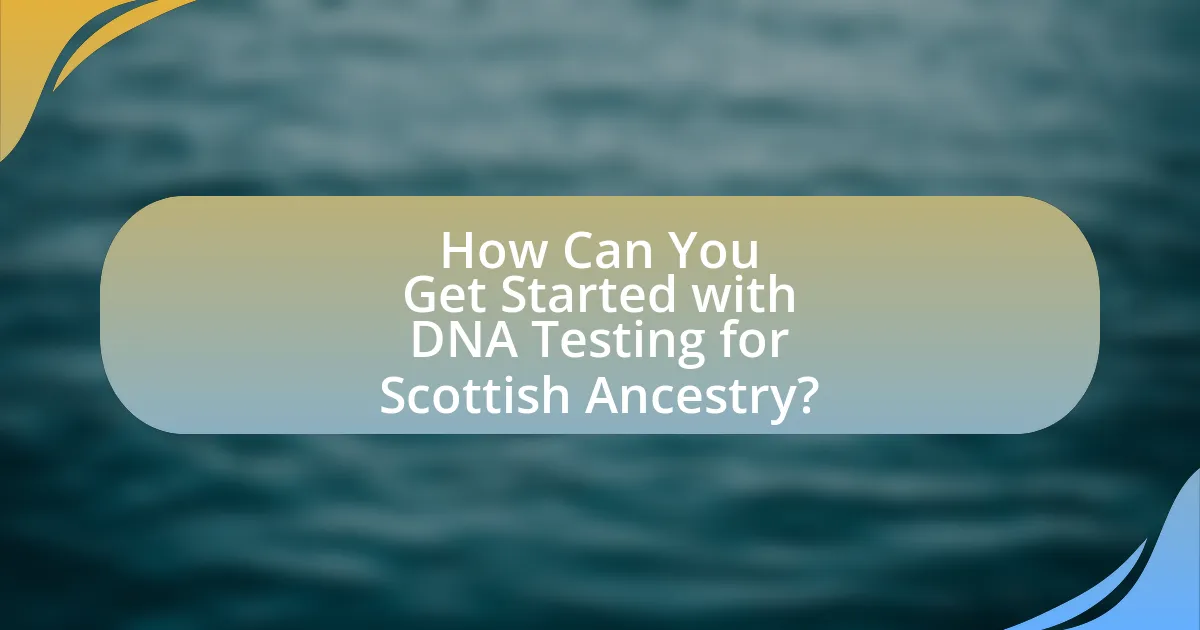
How Can You Get Started with DNA Testing for Scottish Ancestry?
To get started with DNA testing for Scottish ancestry, choose a reputable DNA testing company that offers ancestry services, such as AncestryDNA or 23andMe. These companies provide kits that allow you to collect a saliva sample, which is then analyzed to reveal your genetic heritage. The results typically include information about your ethnic background, including specific Scottish regions and potential relatives. According to a study by the National Geographic Society, genetic testing can trace lineage and provide insights into ancestral origins, making it a valuable tool for those interested in Scottish heritage.
What steps should you take before ordering a DNA test?
Before ordering a DNA test, you should research the different types of tests available and determine your specific goals for testing. Understanding whether you want to explore ancestry, health information, or genetic traits will guide your choice. Additionally, review the credibility and privacy policies of the testing companies, as reputable providers like AncestryDNA and 23andMe have established protocols for data protection. Finally, consider consulting with a genetic counselor if you have specific health concerns or family history that may influence your decision.
How can you prepare your family tree for DNA analysis?
To prepare your family tree for DNA analysis, gather comprehensive genealogical information, including names, birth dates, and relationships of family members. This foundational data is essential for accurately interpreting DNA results and connecting them to specific ancestors. Additionally, documenting any known ethnic backgrounds or geographic origins can enhance the analysis, as DNA testing companies often provide insights into ancestral origins based on genetic markers. Having a well-structured family tree allows for better comparison with DNA matches, facilitating the identification of relatives and understanding genetic heritage.
What questions should you consider when choosing a testing company?
When choosing a testing company for DNA analysis related to Scottish ancestry, consider the following questions: What types of DNA tests do they offer, including autosomal, Y-DNA, and mtDNA tests? How accurate and reliable are their testing methods, and what is their track record in the industry? What databases do they use for ancestry comparisons, and how extensive are these databases? What are the costs associated with their services, including any hidden fees? How is customer support structured, and what resources do they provide for interpreting results? Additionally, what privacy policies are in place to protect your genetic information? These questions help ensure that you select a reputable and effective testing company for your ancestry research.
How do you interpret your DNA test results?
To interpret your DNA test results, analyze the provided data regarding ancestry, genetic traits, and health information. The results typically include percentages of ethnic backgrounds, which indicate your ancestral origins, and may also highlight specific genetic markers linked to certain traits or health conditions. For example, a report might show that you are 30% Scottish, which suggests a significant ancestral connection to Scotland. Additionally, health-related insights can inform you about potential genetic predispositions to certain diseases, allowing for informed lifestyle choices. Understanding these components helps you gain a clearer picture of your genetic heritage and health risks.
What tools are available to help analyze your ancestry results?
Various tools are available to help analyze ancestry results, including DNA testing services, genealogical software, and online databases. DNA testing services like AncestryDNA and 23andMe provide detailed ethnicity estimates and genetic matches, allowing users to connect with relatives. Genealogical software such as Family Tree Maker and Legacy Family Tree enables users to organize and visualize their family history. Additionally, online databases like FamilySearch and MyHeritage offer access to historical records and family trees, facilitating deeper research into ancestry. These tools collectively enhance the understanding of one’s heritage and lineage.
How can you connect with potential relatives identified through DNA testing?
To connect with potential relatives identified through DNA testing, individuals should utilize the messaging features provided by DNA testing platforms, such as AncestryDNA or 23andMe, to reach out directly to matches. These platforms often allow users to send messages to their genetic matches, facilitating communication and the sharing of family history. Additionally, joining online forums or social media groups focused on genealogy can enhance networking opportunities with potential relatives. Research indicates that approximately 30% of users respond to messages from genetic matches, increasing the likelihood of establishing connections.

What Resources and Tools Are Available for Exploring Scottish Ancestry?
Resources and tools available for exploring Scottish ancestry include online databases, genealogical websites, and DNA testing services. Notable online databases such as Scotland’s People provide access to vital records, including birth, marriage, and death certificates, which are essential for tracing lineage. Genealogical websites like Ancestry.com and Findmypast offer extensive collections of Scottish records and family trees, facilitating research into family history. Additionally, DNA testing services such as 23andMe and AncestryDNA allow individuals to uncover genetic connections and ancestral origins, providing insights into Scottish heritage. These resources collectively enhance the ability to explore and understand Scottish ancestry effectively.
What online platforms can assist with Scottish ancestry research?
Online platforms that assist with Scottish ancestry research include Ancestry.com, Findmypast, and MyHeritage. Ancestry.com offers extensive records, including census data and immigration records specific to Scotland. Findmypast specializes in UK records, providing access to Scottish parish registers and military records. MyHeritage features a large database of family trees and DNA matching, which can help connect individuals with their Scottish heritage. These platforms are widely recognized for their comprehensive resources and user-friendly interfaces, making them valuable tools for genealogical research.
How do genealogy websites enhance your understanding of Scottish heritage?
Genealogy websites enhance your understanding of Scottish heritage by providing access to extensive historical records, family trees, and DNA testing services. These platforms allow users to trace their ancestry through vital records such as birth, marriage, and death certificates, which often include information specific to Scottish lineage. For instance, websites like Ancestry.com and MyHeritage offer collections of Scottish census data and parish records that can reveal geographical origins and familial connections. Additionally, DNA testing services offered by these websites can identify genetic links to specific Scottish regions or clans, further enriching the user’s comprehension of their heritage. This combination of historical documentation and genetic analysis creates a comprehensive view of an individual’s Scottish ancestry, making genealogy websites invaluable resources for understanding one’s heritage.
What databases are specifically focused on Scottish records?
The databases specifically focused on Scottish records include Scotland’s People, which is the official government resource for Scottish genealogical records, and the National Records of Scotland, which houses a vast collection of historical documents. Scotland’s People provides access to civil registration records, census data, and parish registers, while the National Records of Scotland offers archival materials that are crucial for genealogical research. These resources are essential for anyone researching Scottish ancestry, as they contain comprehensive and authoritative information on individuals and families in Scotland.
What are some best practices for combining DNA testing with traditional genealogy?
Best practices for combining DNA testing with traditional genealogy include integrating DNA results with documented family trees, utilizing genetic matches to identify potential relatives, and verifying findings through historical records. By aligning DNA data with traditional genealogical research, individuals can enhance their understanding of ancestry. For instance, a study published in the Journal of Genetic Genealogy highlights that combining DNA evidence with historical documentation can lead to more accurate lineage conclusions, as it allows for cross-referencing and validation of familial connections.
How can you effectively document your findings from DNA and genealogy research?
To effectively document findings from DNA and genealogy research, create a structured record that includes detailed notes, source citations, and visual aids such as family trees. This structured approach ensures clarity and traceability of information. For instance, when documenting DNA results, include the testing company, the specific test taken, and the date of the test. Additionally, maintain a log of genealogical sources, such as census records, birth certificates, and historical documents, with proper citations to validate the information. Using software tools like genealogy databases can enhance organization and facilitate easy retrieval of data. This method aligns with best practices in genealogical research, which emphasize the importance of source documentation and evidence-based conclusions.
What common mistakes should you avoid when researching Scottish ancestry?
When researching Scottish ancestry, common mistakes to avoid include relying solely on online databases without verifying information through primary sources. Many individuals mistakenly assume that online family trees are accurate, but these can contain errors or unverified claims. Additionally, overlooking the importance of historical context, such as understanding regional variations in naming conventions and record-keeping practices, can lead to misinterpretations of data. Failing to consider the impact of migration patterns and historical events, such as the Highland Clearances, can also skew research results. Lastly, neglecting to utilize DNA testing as a complementary tool can limit the depth of ancestry exploration, as genetic data can provide insights that traditional records may not reveal.
What tips can help you maximize your DNA testing experience for Scottish ancestry?
To maximize your DNA testing experience for Scottish ancestry, start by selecting a reputable testing company that specializes in genetic genealogy, such as AncestryDNA or 23andMe. These companies provide comprehensive ethnicity estimates and connect you with potential relatives based on shared DNA. Additionally, ensure you understand the testing process and the types of results you can expect, including autosomal, Y-DNA, and mitochondrial DNA tests, which can provide different insights into your ancestry. Engaging with online communities and forums focused on Scottish genealogy can also enhance your experience, as they offer valuable resources and support. Finally, consider combining DNA results with traditional genealogical research, such as historical records and family trees, to create a more complete picture of your Scottish heritage.


